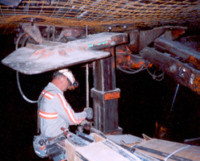|
||||||||||||||||||
 Underground coal miners, especially roof bolter and continuous miner operators, work in a hazardous environment where they are often exposed to poor roof conditions. Nearly 500 rock fall injuries
are reported each year, and 99% of them are caused by rocks falling from between the roof bolts. These loose rocks are usually just a few inches thick, but on average weigh 280
pounds.
Underground coal miners, especially roof bolter and continuous miner operators, work in a hazardous environment where they are often exposed to poor roof conditions. Nearly 500 rock fall injuries
are reported each year, and 99% of them are caused by rocks falling from between the roof bolts. These loose rocks are usually just a few inches thick, but on average weigh 280
pounds.
NIOSH has found that most rock fall injuries can be prevented by installing roof screens during the bolting cycle. Roof screen is a sheet of steel wires in a grid pattern. When a screen is bolted up against the mine roof it provides far more coverage than any common surface control used in mines today. Because more mine roof is covered, there is less chance that a rock will fall and injure a miner.
The facts about roof screens are shown in the NIOSH Mining video "Make It Safer With Roof Screen". Using extensive underground footage, the 7-minute video shows how well screens keep loose rock from falling in difficult roof conditions. Techniques for installing screens for both outside-controlled and walk-through roof bolting machines are shown. The video also provides safe handling tips, best practices, and information about machine technology that can greatly improve material handling. Throughout the video, a coal mine safety manager and a shift foreman talk about the tremendous difference that roof screens have made at their mines.
For more information contact:
Craig Compton
Pittsburgh Research Laboratory
412-386-6604
CCompton@cdc.gov
Dr. Christopher Mark
Pittsburgh Research Laboratory
412-386-6522
CMark@cdc.gov
NIOSH Mining videos can also be found on the NIOSH Videos page.
Related Products:
- Make it Safer With Roof Screen - VHS Video
Related Documents:
- Roof Screening: Best Practices and Roof Bolting Machines (PDF, 514 KB, 2002)
- Technology News 508 - NIOSH Releases New Safety Video: Make It Safer With Roof Screen (PDF, 726 KB, 2005-03)
- Personal Bolter Screen: Surface Control to Protect Underground Workers in Coal Mines (PDF, 297 KB, 2003-08)
- Make it Safer with Roof Screen - Instructional Materials (PDF, 1575 KB, 2005-03)
- Roof Screening for Underground Coal Mines: Recent Developments (PDF, 1421 KB, 2007)